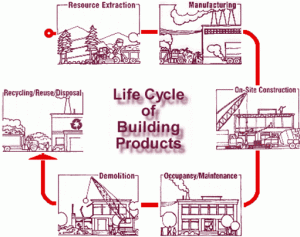There are many reasons for us to change the paradigm regarding how we live. Carbon footprint is the incumbent, quick to evoke a response from most people nowadays, but should it really be our primary focal point or just the tip of the proverbial iceberg?
We’ve recently heard the science behind the Global Warming pundits (challenged last year) has been vindicated by a landslide of evidence corroborating the climate change theory (see www.skepticalscience.com). Our reliance on fossil fuels and the large percentage of fuel used to power, heat and cool our homes and businesses largely impacts our per capita Carbon Footprint.
 This isn’t the only area the built environment impacts:
This isn’t the only area the built environment impacts:
Landfill Waste
A large percentage of construction and demolition waste (including lumber) ends up in landfills each year (in some areas greater than 40% of all waste is from the built environment). This is detrimental in many ways since a large percentage of this waste can actually be reused or recycled on either construction sites (reclaimed lumber, etc.) or by manufacturers in producing new materials (drywall, concrete, etc). Read some landfill and construction waste statistics and their impact regionally.
Water Use
The fact that we are running out of fresh water in North America (and globally) is shocking to many. Our thoughts go to developing countries when we hear ‘water crisis’ but we are not as well off as one might think. Fresh water supply on our planet makes up roughly 2½% of total water supply. That means in many areas a great deal of energy and technology must be applied to create fresh water (reverse osmosis, etc.) and a miniscule portion of this is applied toward potable uses. Residentially, we use most of this supply to bathe, flush toilets, wash clothes and water our lawns. Read the Water Use Statistics on the American Water Association website.
Some Sobering Statistics
The built environment made up:
39% of US Carbon Emissions in 2005 (Source: Energy Information Administration).
40% of Primary Energy Use
70% of Electricity Use
17% of Freshwater Use
Read this PDF for more information.
I’m a realist in looking at this data and the immense footprint our homes and businesses have relating to the items above. Will we wake up and implement the needed changes or are our heads so firmly stuck in the sand that we will remain oblivious to the realities at hand?
I truly hope that we are the solution and have reached the point of a paradigm shift towards environmental sustainability. It will need to happen sooner than later and it definitely should start at home. See the ‘Four Years. Go.‘ website for some compelling reasons why making positive changes are critical and what you can do to start the ball rolling.